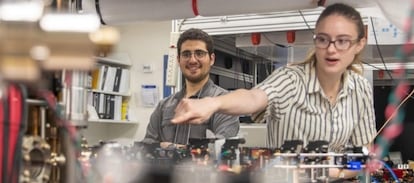Quantum semiconductor found by chance breaks speed record: Up to one million times faster
The superatomic material uses the strategy of the tortoise in the famous fable to allow micrometers of travel in less than a nanosecond. Researchers believe it could even cover that distance in femtoseconds

Physics and chemistry have rewritten the fable of the hare and the tortoise more than 2,500 years after Aesop created it — and this time in the quantum realm. Just as the slow tortoise was able to beat the swift hare thanks to its constancy and strategy, a research group at Columbia University in New York has found by chance a superatomic material, called Re₆Se₈Cl₂ (composed of rhenium, selenium and chlorine), which acts as a semiconductor, allowing electrons in experiments to travel micrometers in less than a nanosecond. “Theoretically, they have the potential to reach femtoseconds, six orders of magnitude [10⁶] faster than the speed achievable in current gigahertz electronics and at room temperature,” the researchers explain.
The finding, published in Science, was serendipitous and thanks to student Jack Tulyag, who is working on his PhD with Columbia assistant professor of chemistry Milan E. Delor. The former brought Re₆Se₈Cl₂ to the lab, believing it to be a material without high conducting capacity, to test super-resolution microscopes, which can capture particles moving at ultrafast, ultramicroscopic scales. “It was the opposite of what we expected. Instead of the slow motion we presumed, we saw the fastest we’ve ever seen,” Delor says.
According to the researcher, silicon-based semiconductors allow fast electron motion that was not believed possible in superatomic material. The experiment led to the discovery that, in Re₆Se₈Cl₂, the exciton (a quantum state formed by electrons that have absorbed energy and the gap created when the particle jumps to a higher energy state) is paired with the phonon, an energy-carrying quasiparticle which is key to electrical conductivity. This association has led to a new quasiparticle, called the acoustic exciton-polaron, which is heavier but, paradoxically, also faster.

Delor draws on Aesop’s fable to explain how this is possible. In silicon, electrons can move very quickly, but like the hare, which is overly confident of its ability, “they bounce around too much and do not get very far or go very quickly in the end.” In contrast, in superatomic material, excitons pair with phonons to move forward, like the tortoise, “slowly, but steadily,” in a “ballistic or scattering-free flow.” This behavior is similar to that of a fluid flowing frictionlessly through a conduit, without losing kinetic energy.
“Being unimpeded in the path, the acoustic exciton-polaron ultimately moves faster in the Re₆Se₈Cl₈Cl₂ than the electrons in silicon,” the researcher explains.
In the experiments, the acoustic exciton-polarons in the Re₆Se₈Cl₈Cl₂ traveled several micrometers in the sample in less than a nanosecond. This speed, taking into account that they can remain stable for about 11 nanoseconds and be controlled with light rather than electricity, means that, theoretically, “they could cover more than 25 micrometers in femtoseconds,” according to the researchers’ calculations.

This theoretical potential is one million times faster than the electron’s speed in silicon, a comparison similar to the difference between the speed of light and the speed of sound or an airplane traveling at 560 miles per hour. Today’s computer processors are similarly 10⁶ faster than the computers of 20 years ago. “In terms of energy transport, Re₆Se₈Cl₂ is the best semiconductor we know of, at least so far,” says Delor.
José Luis Salmerón, the director of the Data Science Lab at Cunef University who was not part of the investigation, explains the significance of the finding: “Energy and information transfer in semiconductors is limited by the dispersion between electronic carriers and phonons in the lattice, which results in losses that restrict all semiconductor technologies. Using a superatomic semiconductor such as Re₆Se₈Cl₂, the authors demonstrate the formation of acoustic exciton-polarons, which are protected against phonon scattering.”
Salmerón — who featured on Elsevier and Stanford University’s list of most cited scientists — emphasizes that the new semiconductor’s structure is organized in layers linked by van der Waals forces: “These are attractive forces that act between atoms and molecules due to temporal fluctuations in electronic charge distributions. This peculiar arrangement gives it semiconducting properties, which means that it can conduct electricity differently from conventional conductors and insulators. What distinguishes Re₆Se₈Cl₈Cl₂ as a superatomic semiconductor is its ability to exhibit exceptional electronic properties that transcend the individual characteristics of its constituent atoms.”
Its potential application in commercial processors is limited because the discovered semiconductor includes rhenium, a rare chemical element on Earth that is used in nickel-based superalloys and, along with molybdenum and tungsten, in aircraft engines, for chemical and petrochemical catalysts and for corrosion-resistant coatings.

However, after two years of work, the research team believes that combinations of other elements can be used to find semiconductors with capabilities similar to those of Re₆Se₈Cl₂. “This is the only material in which sustained ballistic transport of excitons has been observed at room temperature. But now we can begin to predict what other materials that we simply hadn’t considered before might be capable of this behavior. There is a whole family of superatomic semiconductor materials and others that have properties favorable for the formation of acoustic polarons,” says Delor.
Salmerón, a research associate at the Autonomous University of Chile and senior data scientist at Capgemini, agrees: “This discovery offers new perspectives in the search for materials with revolutionary applications in electronics and semiconductor technology. This discovery not only expands our understanding of superatomic semiconductors, but also opens up new possibilities for the development of more efficient and advanced technologies in electronics and computing.”
“In the specific case of Re₆Se₈Cl₂,″ adds the Spanish researcher, “protected polaron transport has been observed, which means that these quasiparticles can move more efficiently and are less affected by interactions with lattice vibrations. This may have significant implications in terms of efficiency and speed in semiconductor and electronics applications.”
“This is a major breakthrough as the ability to have ballistic semiconductors at room temperature is a significant step towards improving electronics technology in terms of efficiency, speed and versatility of possible applications,” concludes Salmerón.
Sign up for our weekly newsletter to get more English-language news coverage from EL PAÍS USA Edition
Tu suscripción se está usando en otro dispositivo
¿Quieres añadir otro usuario a tu suscripción?
Si continúas leyendo en este dispositivo, no se podrá leer en el otro.
FlechaTu suscripción se está usando en otro dispositivo y solo puedes acceder a EL PAÍS desde un dispositivo a la vez.
Si quieres compartir tu cuenta, cambia tu suscripción a la modalidad Premium, así podrás añadir otro usuario. Cada uno accederá con su propia cuenta de email, lo que os permitirá personalizar vuestra experiencia en EL PAÍS.
¿Tienes una suscripción de empresa? Accede aquí para contratar más cuentas.
En el caso de no saber quién está usando tu cuenta, te recomendamos cambiar tu contraseña aquí.
Si decides continuar compartiendo tu cuenta, este mensaje se mostrará en tu dispositivo y en el de la otra persona que está usando tu cuenta de forma indefinida, afectando a tu experiencia de lectura. Puedes consultar aquí los términos y condiciones de la suscripción digital.
More information
Últimas noticias
More than 40 Democratic lawmakers urge Trump in a letter to stop his ‘attempts to undermine democracy in Brazil’
The journal ‘Science’ criticizes Trump’s anti-renewable energy policy: ‘The US is failing to benefit from its own innovations’
Cubans hope for a miracle as dengue and chikungunya spread
The long shadow of the father figure in the films of Rob Reiner
Most viewed
- Christian Louboutin: ‘Young people don’t want to be like their parents. And if their parents wear sneakers, they’re going to look for something else’
- Cartels in Mexico take a leap forward with narco-drones: ‘It is criminal groups that are leading the innovation race’
- ‘El Limones’ and the growing union disguise of Mexican organized crime
- Liset Menéndez de la Prida, neuroscientist: ‘It’s not normal to constantly seek pleasure; it’s important to be bored, to be calm’
- The low-cost creative revolution: How technology is making art accessible to everyone











































